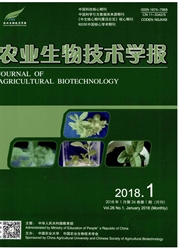

 中文摘要:
中文摘要:
根据GenBank发表的PRSV(番木瓜环斑病毒)中国Sm株系的外壳蛋白基因序列,设计特异引物,以美中红(Caricapapaya L.cv.Meizhonghong)带病样品的RNA为模板进行RT-PCR扩增,将其目的cDNA片段克隆到pGEM-Teasy质粒载体上。以重组质粒作模板,用PCR-DIG标记方法制备cDNA探针,另一种非放射性探针是经凝胶电泳分离、纯化cDNA片段,用碱性磷酸酶直接进行标记。利用地高辛(DIG)标记和碱性磷酸酶直接标记的cDNA探针核酸分子杂交及RT-PCR方法对PRSV进行了检测。结果表明,(1)测序结果表明美中红No.2序列与中国优势株系Sm的同源性为94.7%;(2)DIG标记的3种cDNA探针(861,455和215bp)对样品的总RNA检测结果一致,且861bp的探针杂交斑点最为清晰,上述核酸杂交结果与RT-PCR检测结果相符,核酸分子杂交检测的灵敏度和特异性能满足常规检测的需要;(3)碱性磷酸酶直接标记861bp的cDNA探针可进行PRSV的斑点杂交检测,可获得有效的杂交结果;(4)DIG标记探针对叶脉进行了印迹杂交检测,结果与RT-PCR检测结果相符。
 英文摘要:
英文摘要:
RT- PCR was carried out with specific primers according to published sequences of PRSV (Papaya ringspot virus) CP genes of Chinese Sm strain in GenBank. Using total RNA extracted from PRSV-infected Meizhonghong No.2 of Car/ca papaya L. the cloned eDNA was ligated to pGEM-T easy plasmid vector and sequenced. Recombinant plasmids were used as the template for labelling with DIG PCR Probe Synthesis Kit. Alternatively, AlkPhos direct labelling method was also used to label eDNA recovered from electrophoresis. The results indicated that the sequence of the Meizhonghong No.2 isolate showed 94.7 % identity with the Chinese PRSV-Sm genome; The eDNA probes (861,455 and 215 bp) labelled by DIG produced the identical hybridization result for detecting the PRSV, which were in agreement with that ofRT-PCR, and the clearest hybridization signal was obtained with 861 bp probes, and sensitivity and speciality of nucleic acid hybridization can satisfy the needs of traditional diagnosis; The 861 bp probe from AlkPhos direct labelling could identify PRSV while the 455 bp one was invalid; and DIG labelling probe was also performed in leaf vein and the same result as using RT-PCR was obtained.
 同期刊论文项目
同期刊论文项目
 同项目期刊论文
同项目期刊论文
 期刊信息
期刊信息
